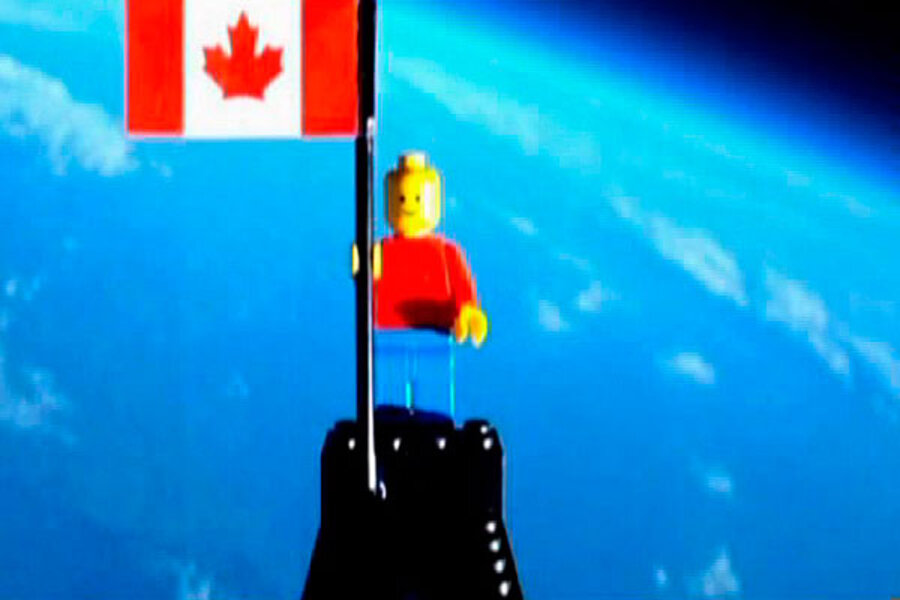Canadian teenagers launch Lego man to the stars
Loading...
Two teens from Toronto,Canada have launched “Lego Man in Space” using a helium filled weather balloon and captured stunning video of the miniature toy figure back dropped by the beautiful curvature of Earth and the desolate blackness of space that’s become a worldwide YouTube sensation – over 2 million hits !
17 year olds Mathew Ho and Asad Muhammad lofted the tiny 2 inch tall Lego figure from a local Toronto soccer field up to a height of about 85,000 feet, or 16 miles (25 kilometers), where the 22 foot (7 m) diameter helium balloon burst in what is technically known as the stratosphere. The homemade styrofoam capsule – equipped with two video cameras and four digital cameras (Canon) – then parachuted back to Earth.
“We launched the project on January 7,” Mathew Ho told Universe Today.
“After endless hours of hard work, we managed to capture stunning views of our atmosphere and put a ‘Lego’ man into near space!” said the ambitious teens who are 12th graders at the Agincourt Collegiate Institute.
The pair posted a YouTube video (below) documenting the entire voyage and some camera snapshots on their website on January 25.
Lego Man even snapped cool Moon shots – look closely at the video and photo below.
"Lego Man in Space" – The Video
The duo recounted the details of their sensational space tale of science on a shoestring for Canadian TV and newspapers.
“Upon launch we were very relieved. But we had a lot of anxiety on launch day because there were high winds when we were going up after all the hard work,” said Ho in a studio interview on Canadian TV (CTV).
“We were also scared because now we would have to retrieve it back after it came down,” Asad chimed in.
“We had no idea it would capture photos like that and would be so good,” said Ho. “We were blown away when we saw them back home.”
The toy Lego astronaut is seen standing atop a thin runway protruding precariously from one end of the small, box shaped capsule as though he was walking the plank and about to plunge into the ocean of space. All the while, cameras were aimed directly out towards him recording the entire rollicking journey from liftoff to the stratosphere to landing, with a constantly changing Earth in the background.
Altogether they netted two videos and 1500 photos.
Coincidentally, several Lego toys are constantly flying even higher above the Earth at this very moment aboard the International Space Station as part of an educational outreach effort by NASA and Lego. And 3 more Lego figurines are speeding to Jupiter aboard NASA’s Juno orbiter.
Legoman’s spectacular journey lasted some 97 minutes. He’s beaming proudly throughout the video while holding the Canadian National flag – the Red Maple Leaf. The rollercoaster-like scenery may well challenge the stomachs of those with fear of heights.
Mathew and Asad worked over about four months one day a week on Saturdays to assemble the rig in Mathew’s kitchen and successfully accomplished the feat on a shoestring budget of merely 400 dollars. They used GPS trackers to locate “Lego Man in Space” and recover the intact capsule holding the imagery.
After the balloon burst at 85,000 feet, the parachute assisted descent back to Earth took about 32 minutes. Winds aloft caused the capsule to drift some 76 miles (122 kilometers) away from the launch site before landing at Rice Lake in one piece.
“We were jumping for joy when we saw the capsule and the parachute. We were ecstatic when we found it,” said Ho.
“We have a long history of passionate building and working together,” Ho told CTV.
The project began after they saw that MIT students had sent a camera to the edge of space with a balloon and captured stunning views.
“We were inspired by videos and pictures we had seen online two years ago and we began working on this in the Fall of 2011. In total the project cost about $400 Canadian,” Ho told me.
“We hope to publish more pictures and video to our Facebook page and website soon,” Ho added.
And now we know another truth about Lego’s – Not only can they withstand the destructive forces of kids, but outer space too!
This post originally ran in Universe Today.





